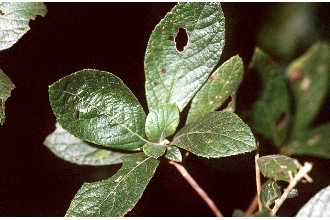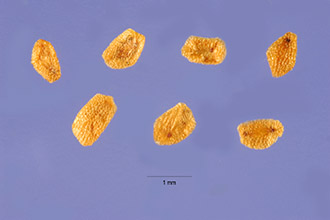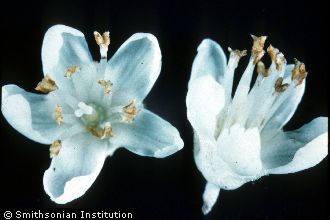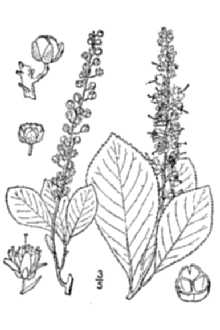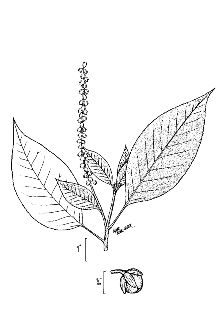Clethra tomentosa Lam.
Scientific Name: Clethra tomentosa Lam.
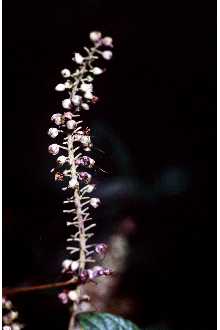
| General Information | |
|---|---|
| Usda Symbol | CLTO |
| Group | Dicot |
| Life Cycle | Perennial |
| Growth Habits | Shrub |
| Native Locations | CLTO |
Plant Guide
Alternate Names
Clethra, Clethra alnifolia var, tomentosa, Clethra angustifolia, Clethra bracteata, Clethra incana, Clethra michauxii, Clethra paniculata, Clethra pubescens, Clethra pumila, Clethra scabra, Clethra tomentosa, poorman’s soap, summer sweet, sweet pepper bush, white alder, Use soil moisture sensors to measure the soil moisture of Clethra tomentosa Lam..,
Uses
Erosion control: Coastal sweet pepperbush spreads by sending up new shoots, forming a thicket of low bushes. Growth from root suckering will provide moderate erosion control along streams and ponds. Garden and landscape: The foliage and flowers of coastal sweet pepperbush make it an attractive garden shrub. It can be used in a mixed shrub hedge or border and pruned to maintain a small size. The lush green leaves turn to golden yellow in autumn. The fragrant flowers last up to 6 weeks or more during the middle of summer while other flowering shrubs are not blooming due to the heat. Utility right of ways: Coastal sweet pepperbush is sometimes used to halt succession of tall trees along pathways. It has been planted following herbicide application along electrical transmission, telephone, railroad, roadside, and pipeline right of ways. Its low stature does not interfere with the general operations around these utility areas. Wildlife: The fragrant white flowers and nectar of coastal sweet pepperbush attract hummingbirds and butterflies. Deer eat it only when other forage vegetation is limited. Birds eat the fruit and aid in seed dispersal. Ducey, V. 2003. USF Herbarium Slide Collection.
Legal Status
Status
Status
Coastal sweet pepperbush is listed as a special concern species in Maine and as threatened in Tennessee. Please consult the PLANTS Web site (http://plants.usda.gov) and your State Department of Natural Resources for this plant’s current status (e.g. threatened or endangered species, state noxious status, and wetland indicator values).
Description
General: White Alder Family (Clethraceae). Coastal sweet pepperbush is a large deciduous shrub that grows to 2.5 m tall. The bark is smooth, reddish-orange or gray in color, and 2 to 3 mm in diameter. Twigs are reddish-orange covered with dense white hairs. Leaves are alternate, simple, 5 to 8 cm long, and toothed toward their tips. They are medium to dark green, turn golden yellow in the fall and have appressed white hairs along the midvein. Flowers are up to 1 mm long and 0.8 mm wide, composed of 5 white fused petals. Seventeen to one hundred fragrant flowers form the bottlebrush-like inflorescences that are about 10 cm long and 2 cm wide. The fruiting stalk has many miniature oval 3-seeded capsules that are winter-persistent and are good identification features. Coastal sweet pepperbush produces leaves in late spring, flowers in July and August, and sets fruit in September and October. The yellow fall foliage persists for two to four weeks. Distribution: This is the only species in the genus Clethra that is native to North America. It occurs from southern Maine and New Hampshire, south to eastern Texas and Florida. For current distribution, please consult the Plant Profile page for this species on the PLANTS Web site (http://plants.usda.gov). Habitat: Coastal sweet pepperbush is found in wet woods, thickets, marshes, swales and bogs, along lake and stream edges, and near rocks in water. It is typically not a dominant species in plant communities. Common overstory associates include cypress, Atlantic white cedar, coastal pine species, red maple, magnolias, and beech.
Adaptation
The USDA hardiness zones for coastal sweet pepperbush are 4 to 9. It grows naturally in poorly drained, moist soils and will get larger and produce more suckers if provided plenty of water. Once established, it can also thrive on drier, well-drained soils. The optimum soil pH is approximately 4.5. Coastal sweet pepperbush is moderately salt tolerant and can be grown near, but not directly behind, beaches. Coastal sweet pepperbush is a shade-tolerant understory shrub that grows under the canopy of old-growth trees. It will grow in full sun, but does best in a light, dappled shade.
Management
Legginess occurs with age among coastal sweet pepperbush plants. Aggressive root suckering also occurs with age, which is an asset if naturalization or moderate erosion control is desired. Coastal sweet pepperbush can build up and create a fire hazard. It can be controlled with regular prescribed burning. Most fires probably top-kill sweet pepperbush, but the plant can resprout from surviving stolons. Fires severe enough to consume the organic soil may kill stolons.
Pests and Potential Problems
Damage caused by spider mites can be severe on plants in hot, dry locations.
Seeds and Plant Production
Plant Production
Plant Production
Coastal sweet pepperbush can be propagated by seeds, summer cuttings, or sucker division. Seeds are cold stratified for 30 days and germinated under spring temperatures. Collect 10 cm long softwood cuttings at the end of May or the beginning of June and strip the leaves from the lower two-thirds of the cutting. Wound the lower portion of the stem and apply a powder or liquid root hormone compound. Place cuttings in coarse sand that is 7 to 10 cm deep and lightly water at least every 2 hours. The medium can be any well-drained mixture that does not contain soil. Provide shade to the cuttings for the first 7 to 10 days to allow the cuttings to harden off before exposing them to full sun. For best rooting results, place cuttings in an intermittent misting system. Cultivars, Improved, and Selected Materials (and area of origin) The USDA NRCS Plant Materials Program has not released any cultivars of coastal sweet pepperbush for conservation use. Several ornamental cultivars are available through commercial nurseries. These cultivars include ‘Anne Bidwell,’ ‘Creels Calico,’ ‘Hummingbird,’ ‘Paniculata,’ ‘Pink Spires,’ ‘Ruby Spice,’ ‘September Beauty,’ and ‘Summersweet Clethra.’ These cultivars have been developed for flower size and color, foliage variegation and shine, plant stature, and extended bloom time. Contact your local Natural Resources
Conservation
Service (formerly Soil Conservation Service) office for more information. Look in the phone book under ”United States Government.” The Natural Resources Conservation Service will be listed under the subheading “Department of Agriculture.”
References
Agricultural Research Center. 2004. GRIN taxonomy (http://www.ars-grin.gov/cgi-bin/npgs/html/index, 17 May 2004). USDA, Beltsville. Baskin, C.C. and J.M. Baskin. 2002.
Plant Traits
Growth Requirements
| Temperature, Minimum (°F) | -23 |
|---|---|
| Adapted to Coarse Textured Soils | Yes |
| Adapted to Fine Textured Soils | No |
| Adapted to Medium Textured Soils | Yes |
| Anaerobic Tolerance | Medium |
| CaCO3 Tolerance | Low |
| Cold Stratification Required | No |
| Drought Tolerance | Low |
| Fertility Requirement | Medium |
| Fire Tolerance | High |
| Frost Free Days, Minimum | 150 |
| Hedge Tolerance | Low |
| Moisture Use | High |
| pH, Maximum | 7.0 |
| pH, Minimum | 4.5 |
| Planting Density per Acre, Maxim | 1700 |
| Planting Density per Acre, Minim | 700 |
| Precipitation, Maximum | 60 |
| Precipitation, Minimum | 35 |
| Root Depth, Minimum (inches) | 16 |
| Salinity Tolerance | None |
| Shade Tolerance | Intermediate |
Morphology/Physiology
| Bloat | None |
|---|---|
| Toxicity | None |
| Resprout Ability | No |
| Shape and Orientation | Erect |
| Active Growth Period | Spring and Summer |
| C:N Ratio | High |
| Coppice Potential | No |
| Fall Conspicuous | No |
| Fire Resistant | No |
| Flower Color | White |
| Flower Conspicuous | No |
| Foliage Color | Green |
| Foliage Porosity Summer | Moderate |
| Foliage Porosity Winter | Porous |
| Foliage Texture | Coarse |
| Fruit/Seed Conspicuous | Yes |
| Nitrogen Fixation | None |
| Low Growing Grass | No |
| Lifespan | Moderate |
| Leaf Retention | No |
| Known Allelopath | No |
| Height, Mature (feet) | 16.0 |
| Height at 20 Years, Maximum (fee | 16 |
| Growth Rate | Moderate |
| Growth Form | Multiple Stem |
| Fruit/Seed Color | Brown |
Reproduction
| Vegetative Spread Rate | Slow |
|---|---|
| Small Grain | No |
| Seedling Vigor | Low |
| Seed Spread Rate | Slow |
| Fruit/Seed Period End | Fall |
| Propagated by Tubers | No |
| Propagated by Sprigs | No |
| Propagated by Sod | No |
| Propagated by Seed | Yes |
| Propagated by Cuttings | No |
| Propagated by Container | Yes |
| Propagated by Bulb | No |
| Propagated by Bare Root | Yes |
| Fruit/Seed Persistence | No |
| Fruit/Seed Period Begin | Summer |
| Fruit/Seed Abundance | Low |
| Commercial Availability | Routinely Available |
| Bloom Period | Summer |
| Propagated by Corm | No |
Suitability/Use
| Veneer Product | No |
|---|---|
| Pulpwood Product | No |
| Protein Potential | Low |
| Post Product | No |
| Palatable Human | No |
| Palatable Graze Animal | Low |
| Palatable Browse Animal | Medium |
| Nursery Stock Product | No |
| Naval Store Product | No |
| Lumber Product | No |
| Fodder Product | No |
| Christmas Tree Product | No |
| Berry/Nut/Seed Product | No |

